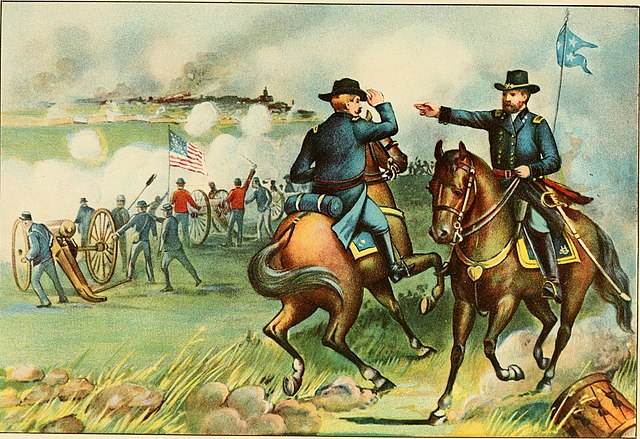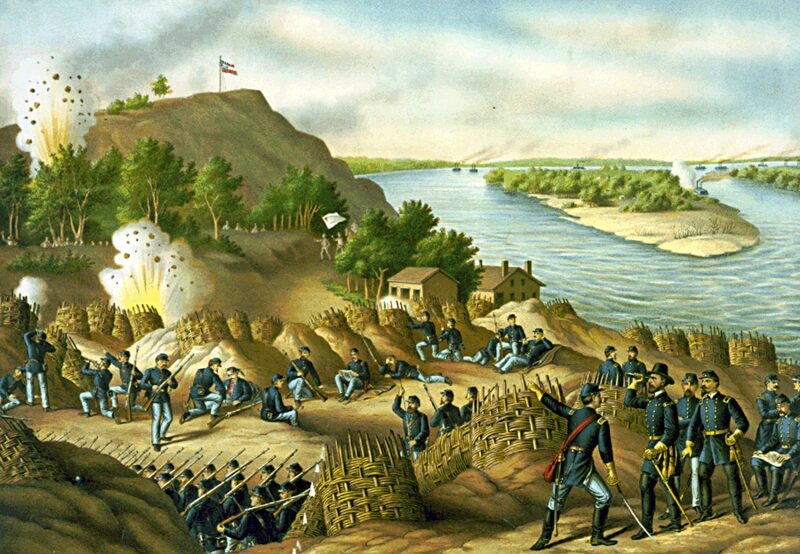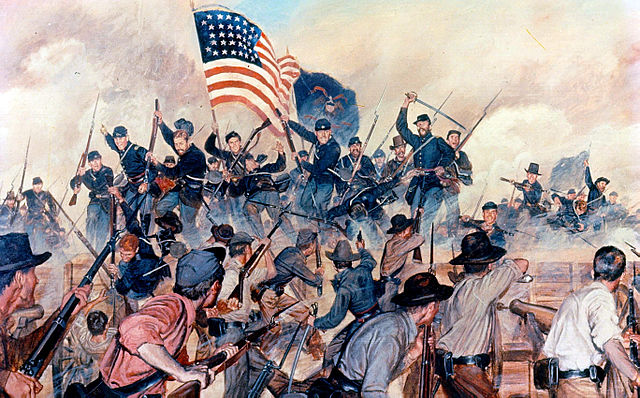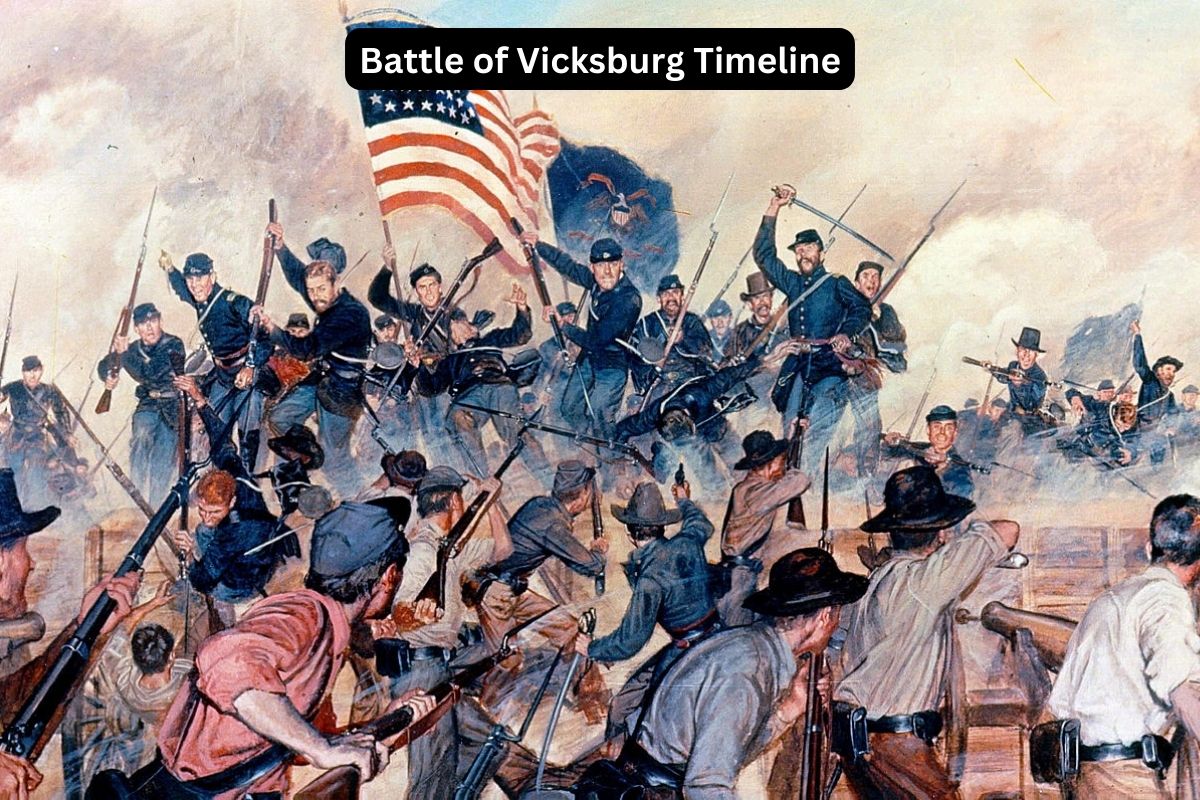The Battle of Vicksburg stands as one of the most decisive and consequential battles of the American Civil War.
Lasting from May 18 to July 4, 1863, this pivotal confrontation between Union and Confederate forces unfolded along the banks of the Mississippi River in Mississippi.
The fall of Vicksburg had far-reaching implications, altering the course of the war and reshaping the strategic landscape of the conflict.
This article delves into the key events and significance of the Siege of Vicksburg, highlighting the intense struggles, tactical innovations, and ultimate triumph that characterized this critical chapter in American history.
| Date | Event |
|---|---|
| April 16, 1863 | Union forces, under Major General Ulysses S. Grant, begin campaign against Vicksburg, Mississippi |
| April 29, 1863 | Grant’s army crosses Mississippi River south of Vicksburg, cutting off supply lines |
| May 1-18, 1863 | Skirmishes and battles as Union forces advance towards Vicksburg, facing stiff Confederate resistance |
| May 18, 1863 | Union forces lay siege to Vicksburg |
| May 22, 1863 | Major assault on Confederate defenses repulsed |
| Late May-Early June 1863 | Union forces dig trenches and fortifications, subjecting city to constant bombardment |
| June 14, 1863 | Confederate General Johnston attempts to break siege but fails |
| June 25, 1863 | Union forces detonate mine under Confederate defenses, assault fails |
| July 1-3, 1863 | Confederate forces attempt breakout, decisively defeated at Big Black River Bridge |
| July 4, 1863 | Vicksburg surrenders to Union forces, major turning point in Civil War |
Timeline of the Battle of Vicksburg
April 16, 1863: Union forces begin campaign against Vicksburg, Mississippi
Union forces, under the command of Major General Ulysses S. Grant, initiate their campaign against Vicksburg, Mississippi, a critical Confederate stronghold situated on the Mississippi River.
Vicksburg’s strategic location made it a vital objective for the Union in controlling the Mississippi River and dividing the Confederacy.

April 29, 1863: Grant’s army crosses Mississippi River south of Vicksburg, cutting off supply lines
Grant’s army executes a daring maneuver by crossing the Mississippi River south of Vicksburg. This bold move effectively severs Grant’s supply lines, as well as his communication with Union forces to the north.
Grant’s army is now operating deep within Confederate territory, heavily reliant on the resources it can secure locally.
May 1-18, 1863: Skirmishes and battles as Union forces advance towards Vicksburg, facing stiff Confederate resistance
The Union forces encounter fierce resistance from Confederate defenders as they advance towards Vicksburg. This period is marked by numerous skirmishes and battles as Grant’s troops navigate difficult terrain and Confederate fortifications.
Confederate General John C. Pemberton, commanding the defense of Vicksburg, employs a strategy of attrition, utilizing the city’s formidable defenses and the challenging Mississippi landscape to thwart Grant’s progress.
Despite facing significant opposition, Grant’s army presses forward, determined to capture Vicksburg and secure control over the vital waterway.
May 18, 1863: Union forces lay siege to Vicksburg
Union forces, under the leadership of Major General Ulysses S. Grant, lay siege to Vicksburg, Mississippi. With the city surrounded, Grant’s army cuts off all supply routes and communication lines, effectively isolating Vicksburg from the outside world.
The siege strategy aims to wear down the Confederate defenders over time, depriving them of essential resources and forcing their surrender.

May 22, 1863: Major assault on Confederate defenses repulsed
In a bold attempt to break the Union siege, Confederate forces mount a fierce defense as Grant launches a major assault on Vicksburg’s defenses.
Despite the Union’s determination and numerical superiority, the Confederate defenders under General John C. Pemberton repulse the assault, inflicting heavy casualties on the Union army.
The failed assault underscores the formidable challenges faced by Grant’s forces in their efforts to capture Vicksburg.
Late May-Early June 1863: Union forces dig trenches and fortifications, subjecting city to constant bombardment
Following the failed assault, Union forces dig trenches and fortifications around Vicksburg, subjecting the city to relentless bombardment. Grant’s troops construct elaborate earthworks and siege lines, inching closer to the Confederate defenses with each passing day.
The siege transforms into a grueling test of endurance for both sides, with Confederate civilians and soldiers enduring extreme hardship as Union artillery shells rain down on Vicksburg.
The prolonged siege takes its toll on morale and resources, exacerbating the dire situation for the Confederate defenders.
June 14, 1863: Confederate General Johnston attempts to break siege but fails
Confederate General Joseph E. Johnston, recognizing the dire situation in Vicksburg, attempts to break the Union siege by reinforcing General John C. Pemberton’s Confederate forces.
Johnston leads his troops in an effort to relieve Vicksburg, hoping to break through the Union lines and provide much-needed reinforcements and supplies to the besieged city.
However, Union control of the Mississippi River prevents Johnston from reaching Vicksburg, and his attempt to break the siege ends in failure.

June 25, 1863: Union forces detonate mine under Confederate defenses, assault fails
In an effort to breach the Confederate defenses, Union forces detonate a mine underneath the Confederate lines. The explosion creates a gap in the defenses, providing an opportunity for a Union assault.
However, the subsequent assault is met with fierce resistance from the Confederate defenders, and the Union forces are unable to exploit the breach. Despite the setback, Union troops continue to maintain the siege, intensifying their bombardment of Vicksburg.
July 1-3, 1863: Confederate forces attempt breakout, decisively defeated at Big Black River Bridge
With Confederate morale plummeting and supplies dwindling, General John C. Pemberton makes a desperate attempt to break out of Vicksburg. Confederate forces launch a series of assaults on Union positions, hoping to break through the encircling Union army and escape to the east.
However, the Confederate assaults are decisively repulsed by Union troops, most notably at the Battle of Big Black River Bridge on July 3. The Union victory at Big Black River Bridge effectively shatters any hope of a Confederate breakout from Vicksburg.
July 4, 1863: Vicksburg surrenders to Union forces, major turning point in Civil War
After enduring 47 days of relentless siege, Confederate General John C. Pemberton surrenders Vicksburg to Union forces. The surrender of Vicksburg is a major turning point in the Civil War, granting the Union control of the Mississippi River and splitting the Confederacy in two.
The capture of Vicksburg is celebrated as a significant victory for the Union, boosting Northern morale and dealing a severe blow to the Confederacy’s war effort.
The surrender of Vicksburg, coupled with the Union victory at Gettysburg just days earlier, marks a turning point in the Civil War and sets the stage for further Union successes in the conflict.
